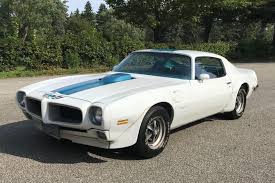
 |
|---|
| Return | Next Favorite |
|---|
 The musclecar revolution was in full swing by the 1970 model year and the cars were becoming more than just
straight line street brawlers that couldn't stop or turn. Pontiac had introduced the Trans Am the year before and it was
touted as a car that handled as well as it accelerated, a concept that was somewhat new to the American performance car.
The musclecar revolution was in full swing by the 1970 model year and the cars were becoming more than just
straight line street brawlers that couldn't stop or turn. Pontiac had introduced the Trans Am the year before and it was
touted as a car that handled as well as it accelerated, a concept that was somewhat new to the American performance car.The General Motors F-Body platform was going through a redesign and the new Firebirds and Camaros hit the ground running as mid year models and deemed 70 1/2 models. Our focus for now is going to be on the Firebird and more specifically the "Top of the Line" Trams Am. The new car had a totally new look on a 108 inch wheelbase and enough new features to make you forget about last year's model. Let me break this down for you: Sit down in the driver's seat and close your eyes. Extend your right arm and lower it down. Your hand lands on the knob of the Hurst 4-speed shifter. Place the thumb edge of your left hand against your left pectoral and push it straight forward. It'll hit that 14-inch padded steering wheel, open your eyes, you're home. Look down at your engine-turned aluminum dash panel and you've got your tach on the left, speedo on the right and smaller gauge pod in the middle with your oil pressure and coolant temp. Two small pods to the right of the steering wheel house the gas gauge and the volt meter.It doesn't take long to realize that this car was designed with somebody sitting behind the wheel. The behind the wheel feel isn't the only thing that made the '70 1/2 Trans Am special, this car was a total package. The base engine was a 400 making 345 horsepower at 5000 RPM and 430 ft./lbs. of torque at 3400. The option was the Ram Air IV with a horsepower rating of 370 @ 5500 and a torque rating of 445 ft./lbs. at 3900. The standard transmission was the 4-speed manual with a Hurst shifter and the Turbo Hydra-matic 400 automatic was the option. The standard rearend gearing was 3.55:1 but you could get the a 3.73:1 gear with the 4-speed. Power front disc brakes were standard and the springs were stiffened for better cornering. Front and rear Heavy-Duty anti-sway bars and a tighter Saginaw power steering box with a 12:1 ratio made this car almost road race ready. Throw in a set of F60x15 Goodyear Polyglas tires on Kelsey-Hayes Rally II rims with no trim rings and you've got yourself a Wide-Track Pontiac that's ready to do battle on the road course or drag strip. Now, the first thing you notice when you see this car is a lot of flashy spoilers and wide stripes. Well, the stripes don't anything for performance but the spoilers are another story. Up front, the air dam, wheel house flares and air extractor vents in the fenders add 50 pounds of downforce at highway speed. Out back it has a good sized rear spoiler with a lot of pitch and wheel house flares at the rear as well. At speeds over 100 miles an hour you can feel the air force pushing the car down. The bottom line is simply this; This car did the work. A base engine car could cover the 1/4 mile in 14.1 at 103 miles an hour and delivered handling that was second only to the Corvette. It only came in two color schemes, white with blue stripes and blue with white stripes. Production was low with only 3196 T/A's built for 1970 with Ram Air IV cars being pretty rare, 29 4-speeds and 59 automatics. - Dan Davis. |